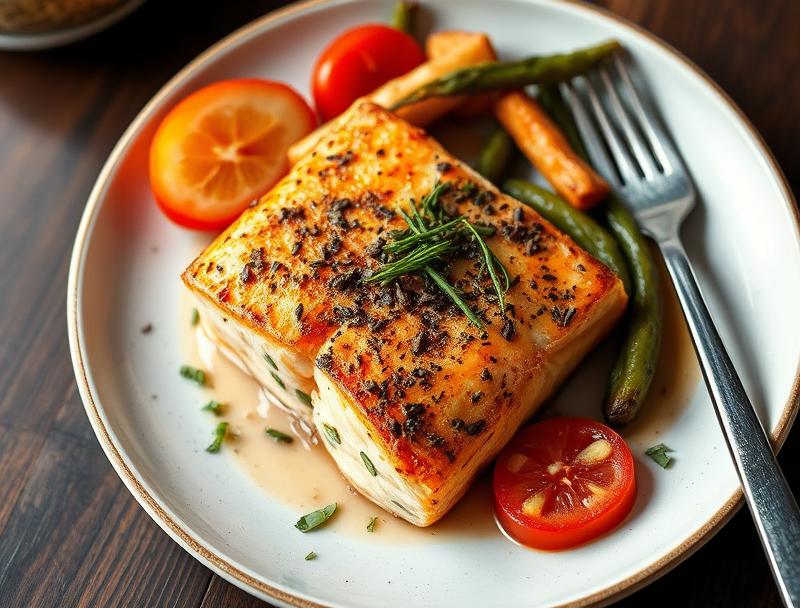Baked Salmon Recipe
Introduction
This baked salmon recipe is a masterpiece of simplicity, requiring only a few everyday ingredients to produce a dish that is both flavorful and visually stunning. With its perfect balance of sweet, savory, and tangy notes, this recipe is sure to become a staple in your kitchen. The best part? It’s incredibly easy to make, requiring minimal effort and preparation time. Whether you’re a seasoned chef or a beginner in the kitchen, this recipe is sure to impress your family and friends with its moist, flaky salmon and delicious glaze.
Why This Works
- Flavor balance and ingredient accessibility: This recipe combines common ingredients like honey, soy sauce, and lemon juice to create a unique and delicious flavor profile that is both easy to make and accessible to everyone.
- Ease of preparation: With only a few ingredients and simple instructions, this recipe is perfect for busy weeknights or special occasions when you want to impress your guests without spending hours in the kitchen.
- Impressive results with minimal effort: Despite its simplicity, this recipe produces a dish that is sure to impress your family and friends with its moist, flaky salmon and delicious glaze.
Ingredients
- 4 salmon fillets (about 6 oz each)
- 3 tablespoons honey
- 2 tablespoons soy sauce
- 1 tablespoon fresh lemon juice
- 1 teaspoon grated fresh ginger
- 2 cloves garlic, minced
- 1 tablespoon olive oil
- Salt and pepper, to taste
- Fresh parsley or chives, chopped (for garnish)
Instructions
- Step 1: Preheat your oven to 400°F (200°C). Line a baking sheet with aluminum foil or parchment paper, and place a wire rack on top. This will help the salmon cook evenly and prevent it from sticking to the pan.
- Step 2: In a small bowl, whisk together the honey, soy sauce, lemon juice, grated ginger, and garlic. Brush the mixture evenly over both sides of the salmon fillets, making sure they are fully coated.
- Step 3: Place the salmon fillets on the prepared baking sheet, leaving about 1 inch of space between each fillet. Drizzle the olive oil over the salmon, and season with salt and pepper to taste.
- Step 4: Bake the salmon in the preheated oven for 12-15 minutes, or until it reaches an internal temperature of 145°F (63°C). Remove the salmon from the oven, and garnish with chopped fresh parsley or chives. Serve immediately, and enjoy!
Handy Tips
- Make sure to pat the salmon dry with paper towels before brushing it with the honey-soy glaze, as excess moisture can prevent the glaze from sticking to the fish.
- If you prefer a crisper crust on your salmon, you can broil it for an additional 1-2 minutes after baking. Keep an eye on it to prevent burning.
- Don’t overcrowd the baking sheet, as this can cause the salmon to steam instead of bake. Cook the fillets in batches if necessary, to ensure they have enough room to cook evenly.
Heat Control
To ensure the salmon is cooked to perfection, it’s essential to control the heat and cooking time. The ideal internal temperature for cooked salmon is 145°F (63°C). You can check the temperature by inserting a food thermometer into the thickest part of the fillet. If you don’t have a thermometer, you can also check for doneness by looking for flaky flesh that separates easily with a fork.
Crunch Factor
The crunch factor in this recipe comes from the crispy, caramelized glaze that forms on the surface of the salmon during baking. To achieve this, make sure to brush the glaze evenly over the salmon, and don’t be afraid to get a little creative with the amount of glaze you use. You can also add some chopped nuts or seeds to the glaze for extra crunch and texture.
Pro Kitchen Tricks
- Use a cast-iron skillet or oven-safe pan to bake the salmon, as these retain heat well and can help create a crispy crust on the fish.
- Don’t overcook the salmon, as this can make it dry and tough. Instead, aim for a moist, flaky texture that’s cooked just until it reaches the desired internal temperature.
- Let the salmon rest for a few minutes before serving, as this allows the juices to redistribute and the fish to retain its moisture and flavor.
Storage Tips
- Leftover salmon can be stored in an airtight container in the refrigerator for up to 3 days. Reheat it gently in the oven or microwave until it reaches an internal temperature of 145°F (63°C).
- Freeze cooked salmon for up to 2 months, and thaw it overnight in the refrigerator before reheating.
- Use a vacuum sealer or airtight container to store the salmon, as this helps prevent moisture and other flavors from affecting the fish.
Gift Packaging Ideas
If you want to give this baked salmon recipe as a gift, consider packaging it in a beautiful wooden or bamboo box, or a decorative tin or jar. You can also add some gourmet touches like fresh herbs, lemon slices, or a side of quinoa or roasted vegetables. Whatever you choose, make sure to include a personalized note or card with the recipe and cooking instructions, so the recipient can enjoy the dish to its fullest potential.
Flavor Variations
- Try adding some diced mango or pineapple to the glaze for a sweet and tangy twist on the recipe.
- Use different types of citrus juice, such as lime or orange, to create a unique flavor profile.
- Add some chopped fresh herbs like parsley, dill, or basil to the glaze for a bright and refreshing flavor.
Troubleshooting
- If the salmon is overcooked, it may become dry and tough. To prevent this, make sure to check the internal temperature regularly, and remove the fish from the oven as soon as it reaches 145°F (63°C).
- If the glaze is too thick, you can thin it out with a little bit of water or lemon juice. If it’s too thin, you can reduce it by cooking it for a few minutes longer, or by adding a little bit of cornstarch or flour to thicken it.
- If the salmon has a strong fishy flavor, you can try soaking it in milk or buttermilk for about 30 minutes before cooking to help remove any impurities and mellow out the flavor.
FAQs
- Can I freeze it? Yes, you can freeze cooked salmon for up to 2 months. Simply thaw it overnight in the refrigerator before reheating.
- Is it gluten-free? Yes, this recipe is gluten-free, making it a great option for those with gluten intolerance or sensitivity.
- Can I double the recipe? Yes, you can easily double or triple this recipe to feed a larger crowd. Just make sure to adjust the cooking time accordingly, and use a larger baking sheet or multiple sheets to accommodate the extra fillets.
Conclusion
This baked salmon recipe is a true showstopper, with its perfect balance of sweet, savory, and tangy flavors, and its moist, flaky texture. Whether you’re a seasoned chef or a beginner in the kitchen, this recipe is sure to impress your family and friends with its ease and simplicity. So go ahead, give it a try, and enjoy the delicious flavors and textures of this amazing dish!

